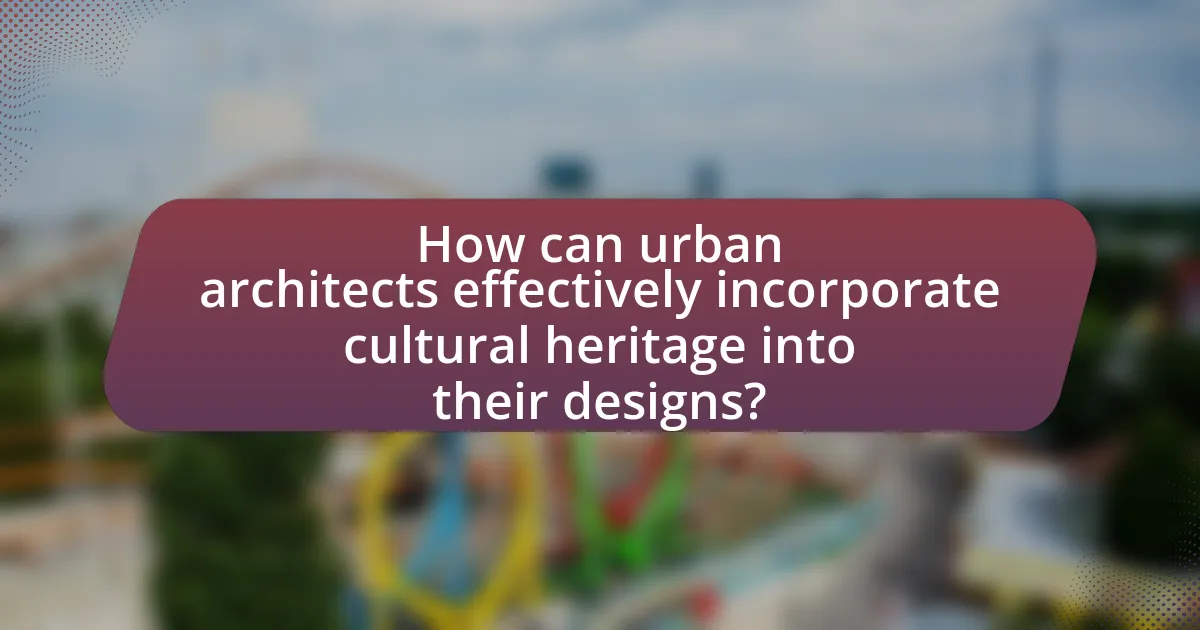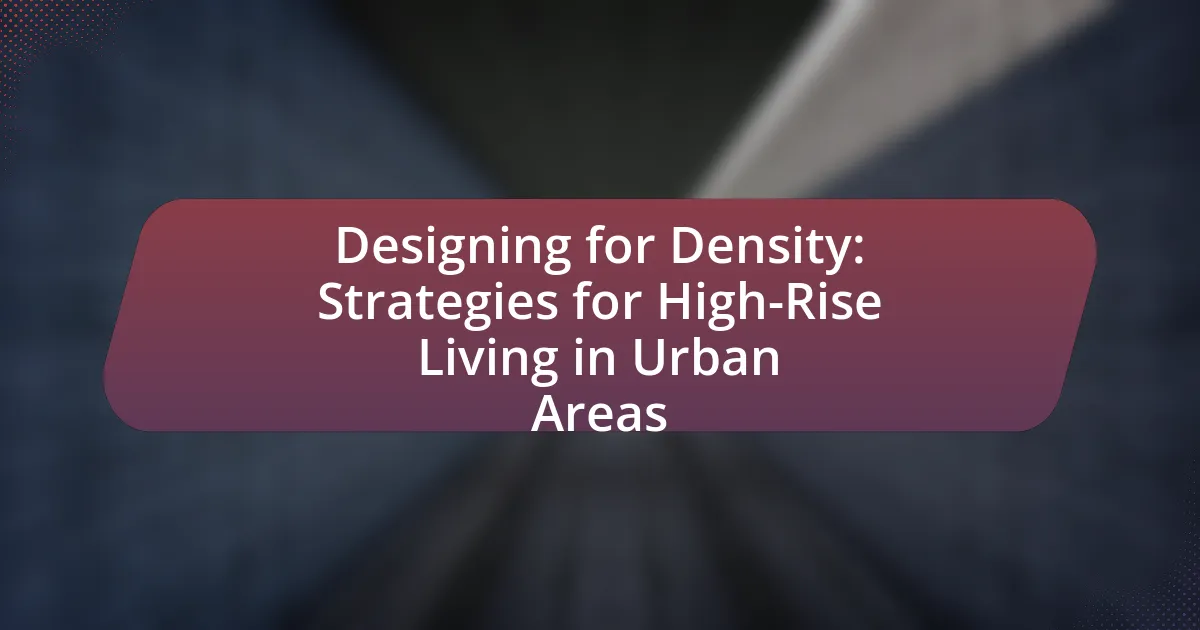The article examines the significant influence of cultural heritage on modern urban architecture, highlighting how historical context, traditional building techniques, and local materials shape contemporary designs. It discusses the integration of cultural symbols and motifs, the impact of historical events on architectural styles, and the importance of preserving heritage in urban development. Additionally, the article explores the benefits of incorporating cultural heritage into urban planning, including enhanced community identity, economic development, and social cohesion, while also addressing the challenges faced by architects and urban planners in balancing modernization with heritage preservation. Successful examples from cities like Barcelona, Kyoto, and Istanbul illustrate effective strategies for blending tradition with contemporary architecture.

What is the Influence of Cultural Heritage on Modern Urban Architecture?
Cultural heritage significantly influences modern urban architecture by shaping design principles, materials, and community identity. This influence manifests through the incorporation of traditional architectural styles, local materials, and historical context into contemporary designs. For instance, cities like Barcelona and Kyoto blend modern structures with historical elements, creating a dialogue between the past and present. Studies show that integrating cultural heritage in urban planning enhances community engagement and fosters a sense of belonging, as seen in the revitalization projects in cities like Istanbul, where historical sites are preserved while accommodating modern needs.
How does cultural heritage shape architectural styles in urban environments?
Cultural heritage significantly shapes architectural styles in urban environments by influencing design elements, materials, and construction techniques. For instance, cities like Kyoto in Japan showcase traditional wooden structures and intricate roof designs that reflect Shinto and Buddhist influences, while European cities often feature Gothic cathedrals and Renaissance buildings that embody historical artistic movements. These architectural styles are not only aesthetic choices but also serve as cultural symbols, preserving local identity and history. Research indicates that urban areas with rich cultural heritage attract tourism and foster community pride, further reinforcing the importance of heritage in shaping contemporary architecture.
What are the key elements of cultural heritage that influence architecture?
The key elements of cultural heritage that influence architecture include historical context, traditional building techniques, local materials, and cultural symbolism. Historical context shapes architectural styles and forms, as seen in cities like Rome, where ancient structures inform modern designs. Traditional building techniques, such as adobe construction in the Southwestern United States, reflect cultural practices and environmental adaptations. Local materials, like limestone in the Mediterranean, not only provide aesthetic value but also connect buildings to their geographical roots. Cultural symbolism, evident in motifs and designs, conveys community identity and values, as observed in the intricate carvings of Hindu temples in India. These elements collectively inform architectural decisions, ensuring that structures resonate with cultural significance and historical continuity.
How do historical events impact modern architectural designs?
Historical events significantly shape modern architectural designs by influencing styles, materials, and urban planning principles. For instance, the Industrial Revolution led to the use of steel and glass, which are now staples in contemporary architecture, as seen in skyscrapers and modernist buildings. Additionally, post-war reconstruction efforts, such as those in Europe after World War II, emphasized functionalism and minimalism, which continue to inform modern design philosophies. The preservation of historical sites and the integration of cultural elements into new constructions reflect a commitment to heritage, as demonstrated by the adaptive reuse of historic buildings in urban areas. This blending of past and present not only honors historical significance but also addresses contemporary needs, illustrating the ongoing dialogue between history and modernity in architecture.
Why is it important to consider cultural heritage in urban architecture?
Considering cultural heritage in urban architecture is crucial because it fosters a sense of identity and continuity within communities. Cultural heritage reflects the historical, social, and aesthetic values of a place, which can enhance the character and uniqueness of urban environments. For instance, cities that integrate historical architecture into their modern designs often experience increased tourism and community pride, as seen in cities like Paris and Rome, where heritage sites attract millions of visitors annually. Furthermore, incorporating cultural heritage can promote sustainable development by preserving existing structures and reducing the need for new construction, thereby minimizing environmental impact.
What benefits does integrating cultural heritage provide to urban communities?
Integrating cultural heritage into urban communities enhances social cohesion and economic development. This integration fosters a sense of identity and belonging among residents, as evidenced by studies showing that neighborhoods with rich cultural heritage often experience lower crime rates and higher community engagement. Additionally, cultural heritage sites attract tourism, which can significantly boost local economies; for instance, UNESCO reports that heritage tourism can generate substantial revenue, creating jobs and supporting local businesses. Thus, the integration of cultural heritage not only enriches the community’s social fabric but also contributes to its economic vitality.
How does cultural heritage preservation affect urban development?
Cultural heritage preservation positively affects urban development by promoting sustainable practices and enhancing community identity. When cities prioritize the conservation of historical sites and cultural landmarks, they often integrate these elements into urban planning, which can lead to increased tourism and economic growth. For instance, cities like Paris and Rome have successfully blended modern infrastructure with preserved heritage, resulting in vibrant urban environments that attract millions of visitors annually. This integration not only fosters a sense of belonging among residents but also encourages investment in local businesses, thereby stimulating the economy.

What are the different ways cultural heritage influences modern urban architecture?
Cultural heritage influences modern urban architecture in several significant ways, including design aesthetics, material choices, and community identity. Firstly, design aesthetics are often derived from historical architectural styles, leading to the incorporation of traditional elements such as arches, columns, and decorative motifs in contemporary buildings. For example, cities like Barcelona showcase a blend of modern structures with Gothic and Moorish influences, reflecting their rich architectural history.
Secondly, material choices in modern urban architecture frequently draw from local heritage, utilizing traditional materials like brick, stone, or wood that resonate with the historical context of the area. This practice not only enhances the visual appeal but also promotes sustainability by using locally sourced materials.
Lastly, cultural heritage plays a crucial role in shaping community identity, as modern urban architecture often aims to reflect the values, traditions, and stories of the local population. This is evident in projects that incorporate public art or memorials that honor historical events or figures, fostering a sense of belonging and continuity among residents.
Overall, the integration of cultural heritage into modern urban architecture enriches the built environment, ensuring that it resonates with the historical and cultural narratives of the community.
How do local traditions and customs manifest in architectural designs?
Local traditions and customs manifest in architectural designs through the incorporation of regional materials, styles, and cultural symbols. For instance, in many Mediterranean regions, the use of terracotta tiles and stucco reflects local climate adaptations and historical building practices. Additionally, architectural elements such as courtyards in Middle Eastern designs serve both functional and cultural purposes, promoting social interaction and privacy in accordance with local customs. These design choices are often influenced by historical context, as seen in the preservation of indigenous building techniques in various cultures, which reinforces community identity and continuity.
What role do materials and construction techniques play in reflecting cultural heritage?
Materials and construction techniques are fundamental in reflecting cultural heritage as they embody the historical, social, and environmental contexts of a community. Traditional materials, such as adobe in Southwestern architecture or timber in Scandinavian designs, showcase local resources and craftsmanship, while construction techniques, like the use of vaulted ceilings in Roman architecture, reveal the technological advancements and aesthetic values of a specific era. For instance, the preservation of historic buildings often relies on using original materials and methods, which not only maintains the structure’s integrity but also honors the cultural narratives associated with those practices. This connection between materials, techniques, and cultural identity is evident in UNESCO World Heritage sites, where adherence to traditional building practices is crucial for maintaining the authenticity and significance of the heritage.
How do cultural symbols and motifs enhance urban architecture?
Cultural symbols and motifs enhance urban architecture by infusing buildings with local identity and historical significance. These elements serve as visual representations of a community’s values, traditions, and heritage, making structures more relatable and meaningful to residents and visitors. For instance, the use of indigenous patterns in the design of public spaces can foster a sense of belonging and pride among local populations, as seen in the incorporation of Maori motifs in New Zealand’s architecture. Additionally, cultural symbols can attract tourism, as unique architectural features often draw visitors interested in experiencing the local culture, thereby boosting the economy. This interplay between cultural motifs and urban design not only enriches the aesthetic appeal of cities but also reinforces social cohesion and cultural continuity.
What challenges arise when integrating cultural heritage into modern architecture?
Integrating cultural heritage into modern architecture presents challenges such as balancing contemporary design with historical significance. Architects often struggle to respect traditional aesthetics while meeting modern functionality and sustainability standards. For instance, the preservation of historical materials and techniques can conflict with the use of modern construction methods, leading to potential structural issues. Additionally, regulatory frameworks may impose restrictions that hinder innovative design solutions, as seen in cities with strict heritage conservation laws. These challenges necessitate a careful negotiation between preserving cultural identity and embracing modern architectural trends.
How do urban planners balance modernization with heritage preservation?
Urban planners balance modernization with heritage preservation by integrating contemporary design with historical context. They achieve this through strategies such as adaptive reuse, where existing structures are repurposed for modern use while maintaining their historical significance. For example, the High Line in New York City transformed an abandoned railway into a public park, preserving its industrial heritage while providing a modern urban space. Additionally, planners often engage in community consultations to ensure that modernization efforts respect local cultural values and historical narratives, thereby fostering a sense of identity and continuity. This approach is supported by studies indicating that cities that successfully blend modern and historical elements tend to enhance both economic vitality and community well-being.
What conflicts can occur between developers and heritage advocates?
Conflicts between developers and heritage advocates primarily arise from differing priorities regarding land use and preservation. Developers often prioritize economic growth and the construction of new buildings, while heritage advocates focus on preserving historical sites and cultural significance. For instance, when a developer seeks to demolish a historic structure to make way for a new project, heritage advocates may oppose this action, arguing that it undermines community identity and historical continuity. This tension is evident in urban areas where rapid development threatens to erase culturally significant landmarks, leading to public protests and legal battles over zoning laws and preservation regulations.

How can urban architects effectively incorporate cultural heritage into their designs?
Urban architects can effectively incorporate cultural heritage into their designs by integrating local historical elements, materials, and architectural styles that reflect the community’s identity. This approach not only preserves the cultural significance of the area but also enhances the aesthetic and functional aspects of new developments. For instance, the use of traditional building materials, such as brick or stone, can create a visual continuity with the past, while incorporating local craftsmanship can foster community pride and economic sustainability. Studies have shown that projects that respect and reflect cultural heritage often receive greater community support and engagement, leading to more successful urban environments.
What strategies can architects use to blend modernity with tradition?
Architects can blend modernity with tradition by incorporating local materials, utilizing traditional architectural forms, and integrating cultural motifs into contemporary designs. For instance, using locally sourced stone or wood not only respects the region’s heritage but also enhances sustainability. Additionally, architects can adapt traditional building techniques, such as vaulted ceilings or courtyards, within modern frameworks, creating a dialogue between old and new. The integration of cultural motifs, like patterns or colors significant to the local community, can further enrich the design, making it relevant and resonant with the cultural context. This approach has been successfully demonstrated in projects like the National Museum of African American History and Culture in Washington, D.C., where modern design elements coexist with historical references, showcasing how tradition can inform contemporary architecture.
How can community engagement enhance the integration of cultural heritage?
Community engagement enhances the integration of cultural heritage by fostering local participation in the preservation and promotion of cultural practices and sites. When communities actively participate, they contribute their unique perspectives and knowledge, which leads to a more authentic representation of cultural heritage in urban architecture. For instance, studies have shown that cities with strong community involvement in heritage projects, such as the “Heritage Lottery Fund” in the UK, have seen increased public interest and investment in preserving local history, resulting in revitalized neighborhoods that reflect their cultural identity. This collaborative approach not only strengthens community bonds but also ensures that cultural heritage is dynamically integrated into modern urban design, making it relevant and accessible to future generations.
What role does technology play in preserving cultural heritage in architecture?
Technology plays a crucial role in preserving cultural heritage in architecture by enabling the documentation, restoration, and dissemination of historical structures. Advanced tools such as 3D scanning and modeling allow for accurate digital representations of buildings, which can be used for restoration efforts and educational purposes. For instance, the use of photogrammetry has been instrumental in creating detailed 3D models of ancient sites, facilitating both preservation and virtual tourism. Additionally, technologies like Building Information Modeling (BIM) support the management of restoration projects by providing comprehensive data on the materials and structural integrity of heritage sites. These technological advancements ensure that cultural heritage is not only preserved but also made accessible to future generations, thereby enhancing public awareness and appreciation of architectural history.
What are some successful examples of cultural heritage integration in urban architecture?
Successful examples of cultural heritage integration in urban architecture include the restoration of the historic district in Barcelona, Spain, where modern buildings harmoniously coexist with Gothic and Modernist structures, preserving the city’s architectural identity. Another example is the High Line in New York City, which transformed an abandoned elevated railway into a public park while incorporating elements of the industrial heritage of the area. Additionally, the Louvre Abu Dhabi integrates traditional Arabic architectural elements with contemporary design, showcasing the region’s cultural heritage while embracing modern aesthetics. These projects demonstrate how urban architecture can respect and reflect cultural history while meeting contemporary needs.
Which cities have effectively showcased their cultural heritage through architecture?
Cities that have effectively showcased their cultural heritage through architecture include Rome, Istanbul, Kyoto, and Barcelona. Rome features ancient structures like the Colosseum and the Pantheon, which reflect its historical significance and architectural innovation. Istanbul’s Hagia Sophia and Topkapi Palace illustrate the city’s rich Byzantine and Ottoman heritage. Kyoto is renowned for its traditional wooden temples and gardens, preserving Japanese culture and aesthetics. Barcelona’s Sagrada Familia and Gothic Quarter highlight the city’s unique Catalan identity and artistic expression. Each of these cities integrates historical architecture into their urban landscapes, demonstrating the enduring influence of cultural heritage on modern architecture.
What lessons can be learned from these successful examples?
Successful examples of integrating cultural heritage into modern urban architecture demonstrate the importance of preserving historical identity while fostering innovation. These cases highlight that blending traditional elements with contemporary design can enhance community engagement and promote tourism. For instance, the restoration of historic buildings in cities like Barcelona has not only maintained cultural significance but also attracted millions of visitors, contributing significantly to the local economy. Furthermore, successful projects often involve community participation, ensuring that the architectural developments reflect the values and needs of local residents. This approach fosters a sense of belonging and pride, reinforcing the idea that architecture can serve as a bridge between the past and the future.
What best practices should architects follow when considering cultural heritage?
Architects should prioritize community engagement and historical research when considering cultural heritage. Engaging with local communities ensures that the voices and values of those who are culturally connected to the heritage are respected and integrated into the design process. Historical research provides architects with a deeper understanding of the architectural styles, materials, and cultural significance of heritage sites, which can inform contemporary designs that honor the past while meeting modern needs. For instance, the Venice Charter of 1964 emphasizes the importance of preserving the authenticity of cultural heritage, guiding architects to maintain the integrity of historical sites. By following these best practices, architects can create designs that are not only functional but also culturally resonant and historically informed.





